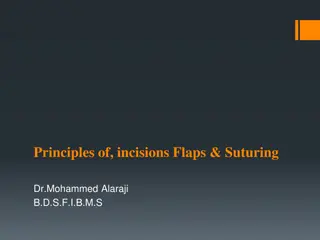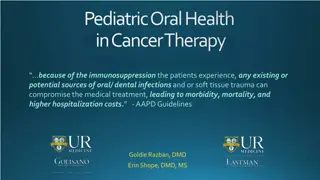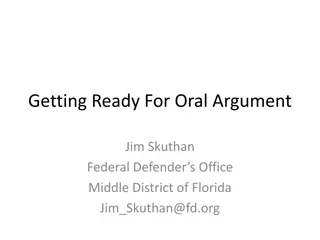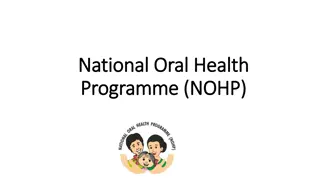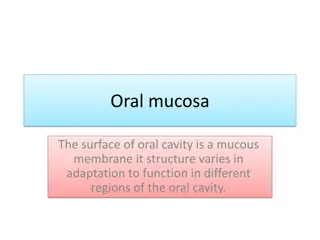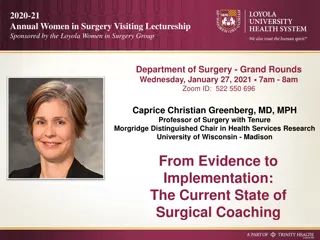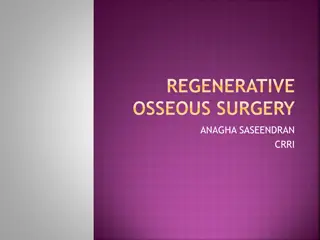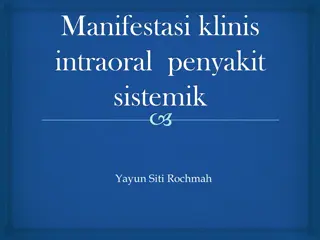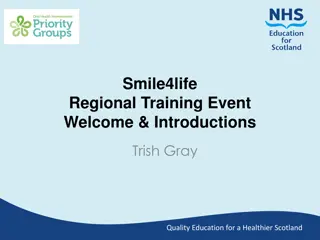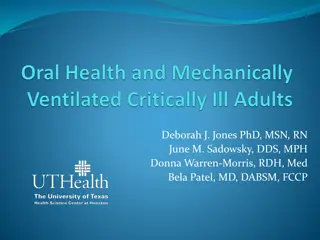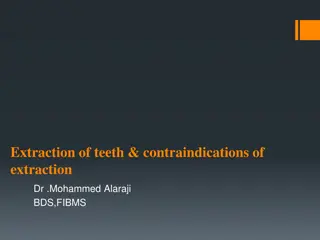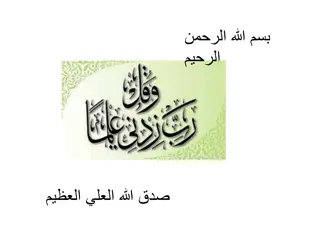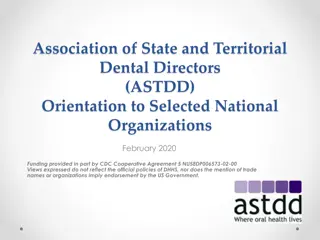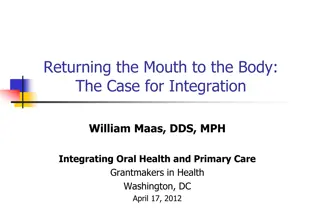Overview of Oral and Maxillofacial Surgery by Dr. Mohammed Alaraji
Oral and maxillofacial surgery is a specialized branch of dentistry focusing on diagnosing and treating various conditions in the orofacial region. Dr. Mohammed Alaraji discusses the art and importance of this field, covering procedures such as extractions, tumor treatment, trauma management, and reconstructive surgeries. The management process involves history-taking, clinical examinations, investigations, and treatment planning to ensure comprehensive care for patients.
Download Presentation

Please find below an Image/Link to download the presentation.
The content on the website is provided AS IS for your information and personal use only. It may not be sold, licensed, or shared on other websites without obtaining consent from the author.If you encounter any issues during the download, it is possible that the publisher has removed the file from their server.
You are allowed to download the files provided on this website for personal or commercial use, subject to the condition that they are used lawfully. All files are the property of their respective owners.
The content on the website is provided AS IS for your information and personal use only. It may not be sold, licensed, or shared on other websites without obtaining consent from the author.
E N D
Presentation Transcript
Oral and maxillofacial surgery Introduction Dr.Mohammed AIaraji B.D.S.F.I.B.M.S
Oral and maxillofacial surgery: is a branch of dentistry, that deals with the art of diagnosis and treatment of various diseases, injuries and defects involving the orofacial region. Oral surgery forms the connecting between medical and dental specialities.
The oral and maxillofacial include the following: Simple and complicated extractions of teeth and related management. Treatment of cysts and tumours of both odontogenic and non odontogenic origin, Management of disorders of maxillary sinuses. Intial and definitive management of traumatic injuries . Temporomandibular joint disorders including internal derangement and ankylosis. Salivary gland diseases and their management. Diagnosis and management of dentofacial deformities. Management of orofacial infections involving the soft and hard tissues. Pre-prosthetic surgical procedures including implantology. Precancerous lesions such as, oral submucousfibrosis and leukoplakia. Detection and management of oral cancer. Management of orofacial pain. Reconstruction of missing portion of jaw bones with bone graft. Detection and management of facial neuropathy.
The management include the following: 1. History taking 2. Clinical examination 3. Investigations (laboratory investigations , radiological analysis ) 4. Provisional diagnosis 5. Final diagnosis and treatment plan
History taking: The aim of history taking is to obtain a correct account of the patient' problems, taking into consideration his/ her symptoms, general condition, lifestyle, and socioeconomic background. Symtoms: Means a subjective problem that the patient describes e.g. pain, parasthesia. Signs: Means an abnormal presentation detectable by the clinicaian, e.g. swelling, ulcer. So detection of signs and symptoms of a disease may aid in diagnosis of that disease
Components of the patient history: the case history may include commonly the following sections or components: 1. . Biographic data (personal details) 2. Chief complaint C/C. 3. . History of chief complain ( history of the present illness) H.P.I. 4. . Past dental history (P.D.H) 5. . Past/ present medical history 6. . family history
Chief complaint/s The chief complaint ascertains the principal reason as to why the patient is seeking medical attention. Most common chief complaint: Pain, Swelling, Bleeding, Loose teeth, Delayed tooth eruption, Recent occlusal problems, Burning sensation, Bad taste, Halitosis, Xerostomia, Parasthesia and anaesthesia.
History of chief complain ( history of the present illness) : The following details are recorded: 1. Duration (record the length of the complaint) 2. Onset (date of onset , manner of onset ) 3. Precipitation / predisposing factor, (e.g. hot, cold, sweet ) 4. Characteristic, and this includes : a) Nature e.g. ( continuous, intermittent , stabbing ) b) Severity e.g. ( mild, sever, very sever) c) Location d) Radiation ( feeling of pain in site other than that of causative lesion, . e) Temperature features f) Aggravating factors g) Relieving factors h) Associated constitutional symptoms and signs. 5. Course and progress. 6. Therapy: a) Type of therapy b) Effect of therapy c) Date of therapy
Past dental history It is the component of the patient's history that is particularly pertinent in the education of the dental patient significant items that should be recorded. 1. The frequency of past treatment, previous restorative, periodontic, endodontic, or oral surgical treatment. 2. Reasons for loss of teeth towards complication of dental treatment. 3. Attitude towards previous dental treatment. 4. Experience with orthodontic appliance and dental prosthesis. 5. Fluoride history including supplement and the use of well water. 6. Radiation or other treatment for facial or oral lesion.
Past/ present medical history. Cardiovascular disorders .. Diseases of the respiratory .. Neurologic conditions . Diseases of the endocrine system . Haematological disorders . Renal pathologies . Disorders of the liver .. Autoimmune disorders .. Psychiatric ailments stress, depression, sleep disturbance, anxiety . Digestive system loss of appetite, loss of weight, polydipsia, polyuria. Musculoskeletal: Joint pain, stiffness, swelling. Dermatology: rash, itching, bruising, discoloration. Allergy to any drug. Childhood illness/ birth trauma. Details of previous hospitalization, blood transfusions and surgeries. Past/ present history of radiation therapy. Current/ past medications taken
Patient present with " pain " If patient comes with a chief complaint (pain ) very detailed history of the pain should be taken and particular attention paid to following points a)The duration of pan . b)Site of the pain . c)Any radiation of the pain.. d) The precise characteristic of the pain : The pain maybe described as a sharp, sever, dull, throbbing,, lancinating, mild, continuous, intermittent, all these objective can be applied to the pain in different pathological process which may help you in diagnosis. (In acute pulpitis, the pain is sharp and sever, in acute dental abscess the pain is dull, and sever and the tooth tender, in acute maxillary sinusitis the pain is dull, throbbing and continuous). e) Timing of pain : . f) Any factors which precipitate the pain . g) Factors or any drugs which relieve the pain : . h) The presence of the symptoms: Like the patient that says that the pain started for two days, then a swelling appeared after that or discharging sinus appeared or a discharge of pus, or pain, swelling then parasthesia of the lower lip... i) The patient also may be asked about relevant past medical history which may assist you in diagnosis of pain like patient with facial pain of vascular origin like migraine, or chronic psychosomatic origin or angina (angina pectoris) pain. In addition to that the patient asked about his opinion of the cause of the pain.




